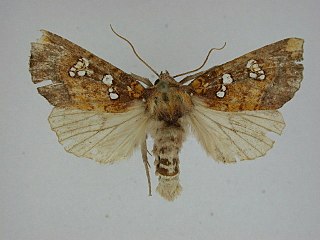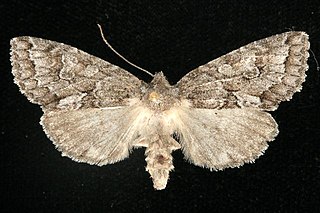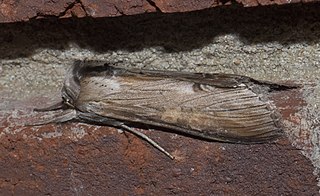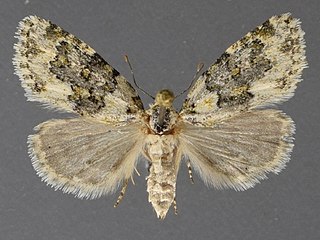Cryphia pallidioides is a species of moth in the family Noctuidae. It is found in North America.
Cryphia flavidior is a species of moth in the family Noctuidae. It was first described by William Barnes and James Halliday McDunnough in 1911 and it is found in North America.

Condica charada is a species of moth in the family Noctuidae. It is found in North America.
Lacinipolia spiculosa is a species of cutworm or dart moth in the family Noctuidae. It is found in North America.

Papaipema rutila, the mayapple borer moth, is a species of cutworm or dart moth in the family Noctuidae. It is found in North America.
Euaontia semirufa is a species of moth in the family Erebidae. It was first described by William Barnes and James Halliday McDunnough in 1910 and it is found in North America.
Properigea suffusa is a species of cutworm or dart moth in the family Noctuidae. It was first described by William Barnes and James Halliday McDunnough in 1912 and it is found in North America.
Lithophane contra, the anti-pinion, is a species of cutworm or dart moth in the family Noctuidae. It was first described by William Barnes and Foster Hendrickson Benjamin in 1924 and it is found in North America.
Nadata oregonensis is a species of moth in the family Notodontidae. It was first described by Arthur Gardiner Butler in 1881 and it is found in North America.
Anarta alta is a species of cutworm or dart moth in the family Noctuidae first described by William Barnes and Foster Hendrickson Benjamin in 1924. It is found in North America.
Tyrissa multilinea is a species of moth in the family Erebidae. It was first described by William Barnes and James Halliday McDunnough in 1913 and it is found in North America.

Xylotype arcadia, the acadian sallow, is a species of cutworm or dart moth in the family Noctuidae. It was first described by William Barnes and Foster Hendrickson Benjamin in 1922 and it is found in North America.
Scotogramma harnardi is a species of cutworm or dart moth in the family Noctuidae first described by William Barnes and Foster Hendrickson Benjamin in 1924. It is found in North America.

Datana modesta is a species of moth in the family Notodontidae. It was first described by William Beutenmüller in 1890 and it is found in North America.
Cucullia pulla is a species of moth in the family Noctuidae. It was first described by Augustus Radcliffe Grote in 1881 and it is found in North America.

Cucullia asteroides, known generally as the goldenrod hooded owlet or asteroid moth, is a species of moth in the family Noctuidae. It is found in North America.
Plagiomimicus ochoa is a species of moth in the family Noctuidae. It was first described by William Barnes in 1904 and it is found in North America.
Elymiotis notodontoides, the glossy prominent, is a species of moth in the family Notodontidae. It was first described by Francis Walker in 1857 and it is found in North America.

Cryphia fascia is a species of moth in the family Noctuidae.
Bleptina flaviguttalis is a species of litter moth in the family Erebidae first described by William Barnes and James Halliday McDunnough in 1912. It is found in North America.





